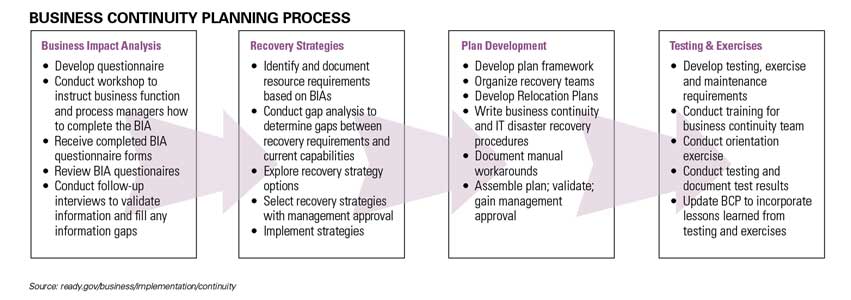By dedicating a small amount of time and resources, businesses can increase their resiliency in the event of a disaster.
Almost one third of businesses fail to reopen following a major catastrophe. In our region, that would affect a staggering number of companies and individuals—not including the effects on our economy and community resources. Any number of emergencies, including natural disasters, could threaten any business that is not prepared. While the most important pieces in preparing any business plan include time, money and resources, an integral part should also include business continuity of operations.
A Sobering Prediction
The Centers for Disease Control and Prevention (CDC), the U.S. government agency assigned the task of protecting us from all sorts of nasty diseases and infections, has made a sobering prediction on one specific disease that could affect the whole country, including our business community: expect an influenza pandemic in the coming years.
The CDC predicts that as many as 25 to 30 percent of the U.S. population could be affected by the expected pandemic, impacting the financial and operational aspects of the American business community. Businesses would not be able to adequately operate in the event of massive absences from the workforce due to sickness, quarantine or isolation. Everyday businesses would be affected, including healthcare, food establishments, groceries, retail and communication companies.
So how do we as individuals, business owners or the government prepare our business community for a pandemic of influenza? We promote business continuity planning. This planning refers to maintaining business functions and being able to quickly resume functions in the event of a major disruption. A Continuity of Operations Plan (COOP) outlines procedures and tasks a business will follow in the event of a disaster. An organization’s resiliency, or continuity capability, is the ability to continue performing essential functions and is directly related to the plan’s outlined procedures and preparedness activities. This resiliency capability relies on four key components that are the foundation of continuity planning and program management: leadership, staff, communications and facilities.

The Foundation of Continuity Planning
When developing a COOP, special attention should be paid to these four components to ensure business continues to meet its mission during and after a disaster:
- Leadership. A prolonged reduction in the workforce due to the impacts of a pandemic may require that businesses prioritize their essential business functions and for a period of time prepare to suspend other, non-essential business functions. When planning for disasters, leaders should decide which aspects of the business are critical for maintaining operations and implement the plan when needed. Continuity planning should include planning for senior leadership, since continuity of leadership during a crisis will reassure staff and the community of the company’s ability to continue necessary operations during disaster response and recovery.
- Staff. Because a person infected by a virus could be contagious for up to 24 hours before the actual signs of infection are noticeable (and then seven days thereafter), it will be difficult to keep any virus from spreading throughout the population. In order to limit the spread of infection, healthcare and government officials may recommend the use of a non-pharmaceutical intervention known as "social distancing," restricting where and when groups of people gather: staying home from work or school, cancelling large events, closing buildings. To address social distancing and still continue operations, businesses may consider the implementation of telecommuting to reduce the number of employees that need to travel to and from work to limit close contact with other people and thus the virus itself.
A strong telecommuting policy should cover all operating units and technical infrastructure needs. Cross training of critical jobs might need to be undertaken. Documentation of critical functions for staff may need to be developed, including a listing of titles, roles and responsibilities; necessary training and skills; process flows and descriptions; as well as staffing levels. These plans for critical functions will act as training aids for those who will be required to fill in for ill or absent coworkers. - Communications. An everyday function that becomes absolutely essential during a crisis is communications. Power and cellular service may be interrupted by disaster. Identifying and regularly testing the communication requirements is a necessary part of the continuity plan. During any emergency, it will be important to maintain interoperability and communications, and have redundancy plans in place for contact with suppliers, other businesses and community partners.
- Facilities. Identifying an alternative facility from which to operate may be needed in the event your current location is damaged during a disaster. In addition, companies may need to establish additional supply and delivery chain alternatives. There will undoubtedly be widespread impacts on the shipping and receiving of necessary goods and services to sustain business. Getting consultants, service personnel and sales people to their client locations may be affected by travel restrictions placed by governmental authorities. Businesses need to make sure that their suppliers are also prepared for the special circumstances brought about by a pandemic and have necessary contingencies in place.
We rarely get notified that a disaster or emergency is about to strike. And even with some lead time, multiple things can (and probably will) go wrong because every incident is unique and unfolds in unexpected ways. However, business owners are not helpless or at the mercy of all potential hazards.
By dedicating a small amount of time and resources now to the development of continuity-of-operations plans, businesses can increase their resiliency to a disaster. Practice the plan with your leaders and staff, and give your organization the best possibility of success during and after a disaster. For assistance with developing a COOP, visit ready.gov/business/implementation/continuity. iBi
Marks serves as Emergency Preparedness Coordinator at Peoria City/County Health Department, using his expertise to assure a prepared response to threats to the public’s health. Learn more about the benefits of public health policies and programs at pcchd.org.


